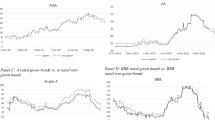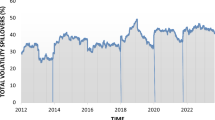Abstract
This study examines the co-movement and causality relationship between prices of crude oil, precious metals, and agricultural commodities. We use a novel approach called wavelet coherence analysis, which allows the measurement of co-movements in the time–frequency space based on the daily prices of commodities. We decompose data from September 1986 to September 2017 into 12 levels and 5 subperiods to find more generalized and convincing results. We confirm that commodity prices are in-phase and co-move. Particularly, the coherence is the largest in the long term and rises sharply in the mid-term during the crisis period. The heterogeneous directions of arrows provide strong evidence that the causality relationship between commodity prices varies over time for different frequencies. We find that the mixed commodities portfolio can provide diversification benefits in the mid-term horizons. The findings of this study can guide investors who want to benefit from diversification while investing in commodity markets.







Similar content being viewed by others
Notes
The various decomposition levels we obtain correspond to the following time scales: Level 1 (1–2 days); Level 2 (2–4 days); Level 3 (4–8 days); Level 4 (8–16 days); Level 5 (16–32 days); Level 6 (32–64 days); Level 7 (64–128 days [half a year]); Level 8 (128–256 days [1 year]); Level 9 (256–512 days [2 years]); Level 10 (512–1024 days [4 years]); Level 11 (1024–2048 days [8 years]); Level 12 (2048–4096 days [16 years]).
For \( \omega_{0} = 6 \), we obtain the approximate equation \( f = \frac{{\omega_{0} }}{2\pi s} = \frac{6}{2\pi s} \approx 1/s \), suggesting that broad scale s corresponds to low Fourier frequency \( f \) and fine scale s corresponds to high Fourier frequency \( f \).
As noted by Daubechies (1992), the admissibility condition is defined as \( 0 < C_{\psi } = \mathop \smallint \limits_{0}^{\infty } \frac{{|\varPsi (f)|^{2} }}{f}{\text{d}}f < \infty \).
The Fourier power spectrum of an AR(1) process with lag-1 autocorrelation \( \alpha \) is given by \( P_{f} = \frac{{1 - \alpha^{2} }}{{|1 - \alpha e^{ - 2i\pi k} |^{2} }} \) (estimated from the observed time series; see, for example, Allen and Smith 1996).
For example, in our analysis, the 5% significance level is calculated using \( Z_{2} \left( {0.95} \right) = 3.999 \).
See Grinsted et al. (2004) for more details.
References
Abbott PC, Hurt C, Tyner WE (2008) What’s driving food prices? Farm found issue report, July 2008
Addison P (2002) The illustrated wavelet transform handbook. The Institute of Physics, London
Aguiar-Conraria L, Soares MJ (2011) Business cycle synchronization and the Euro: a wavelet analysis. J Macroecon 33:477–489
Aguiar-Conraria L, Soares MJ (2013) The continuous wavelet transform: moving beyond uni- and bivariate analysis. J Econ Surv 28:344–375
Aguiar-Conraria L, Azevedo N, Soares MJ (2008) Using wavelets to decompose the time–frequency effects of monetary policy. Phys A 387:2863–2878
Aguiar-Conraria L, Martins MMF, Soares MJ (2012) The yield curve and the macro-economy across time and frequencies. J Econ Dyn Control 36:1950–1970
Akoum I, Graham M, Kivihaho J, Nikkinen J, Omran M (2012) Co-movement of oil and stock prices in the GCC region: a wavelet analysis. Q Rev Econ Financ 52:385–394
Allen MR, Smith LA (1996) Monte Carlo SSA: detecting irregular oscillations in the presence of coloured noise. J Clim 9:3373–3404
Aloui C, Hkiri B, Nguyen DK (2015) Real growth co-movements and business cycle synchronization in the GCC countries: evidence from time–frequency analysis. Econ Model 52:322–331
Arouri MH, Hammoudeh S, Lahiani A, Nguyen DK (2013) On the short- and long-term efficiency of energy and precious metal markets. Energy Econ 40:832–844
Bildirici ME, Turkmen C (2015) Nonlinear causality between oil and precious metals. Resour Policy 46:202–211
Bloomfield D, McAteer R, Lites B, Judge P, Mathioudakis M, Keena F (2004) Wavelet phase coherence analysis: application to a quiet-sun magnetic element. Astrophys J 617:623–632
Cai XJ, Tian S, Yuan N, Hamori S (2017) Interdependence between oil and East Asian stock markets: evidence from wavelet coherence analysis. Int Financ Mark Inst Monty 48:206–223
Cazelles B, Chavez M, Magny G, Guégan J-F, Hales S (2007) Time-dependent spectral analysis of epidemiological time-series with wavelets. J R Soc Interface 4:625–636
Cheung SC, Miu P (2010) Diversification benefits of commodity futures. Int Financ Mark Inst Monty 20:451–474
Connor J, Rossiter R (2005) Wavelet transforms and commodity prices. Stud Nonlinear Dyn E 9:1–22
Daskalaki C, Skiadopoulos G (2011) Should investors include commodities in their portfolios after all? New evidence. J Bank Financ 35:2606–2626
Daubechies I (1992) Ten lectures on wavelets, vol 61. CBMS-NSF regional conference series in applied mathematics. Society for Industrial and Applied Mathematics, Philadelphia
Davidson R, Labys WC, Lesourd J (1997) Wavelet analysis of commodity price behavior. Comput Econ 11:103–128
Diamandis PF (2009) International stock market linkages: evidence from Latin America. Global Finance J 20:13–30
Farge M (1992) Wavelet transforms and their applications to turbulence. Annu Rev Fluid Mech 24:395–457
Furlong P, Ingenito R (1996) Commodity prices and inflation. FRBSF Econ Rev 96:27–47
Goupillaud P, Grossman A, Morlet J (1984) Cycle-octave and related transforms in seismic signal analysis. Geoexploration 23:85–102
Grinsted A, Moore JC, Jevrejeva S (2004) Application of the cross wavelet transform and wavelet coherence to geophysical time series. Nonlinear Proc Geophys 11:561–566
Hammoudeh S, Sari R, Ewing BT (2008) Relationships among strategic commodities and with financial variables: a new look. Contemp Econ Policy 27:251–264
Hudgins L, Friehe C, Mayer M (1993) Wavelet transforms and atmospheric turbulence. Phys Rev Lett 71:3279–3282
Jammazi R (2012) Cross dynamics of oil-stock interactions: a redundant wavelet analysis. Energy 44:760–777
Jammazi R, Aloui C (2012) Crude oil price forecasting: experimental evidence from wavelet decomposition and neural network modeling. Energy Econ 34:828–841
Ji Q, Fan Y (2012) How does oil price volatility affect non-energy commodity markets? Appl Energy 89:273–280
Jiang C, Chang T, Li XL (2015) Money growth and inflation in China: new evidence from a wavelet analysis. Int Rev Econ Finance 35:249–261
Madaleno M, Pinho C (2014) Wavelet dynamics for oil-stock world interactions. Energy Econ 45:120–133
Mallat S (1999) A wavelet tour of signal processing. Elsevier Science, Amsterdam. ISBN 9780080520834
Mitchell D (2008) A note on rising food prices. World Bank policy research working paper series no. 4682. http://ssrn.com/abstract=1233058. Accessed 26 June 2017
Naccache T (2011) Oil price cycles and wavelets. Energy Econ 33:338–352
Nazlioglu S (2011) World oil and agricultural commodity prices: evidence from nonlinear causality. Energy Policy 39:2935–2943
Nazlioglu S, Soytas U (2012) Oil price, agricultural commodity prices and the dollar: a panel cointegration and causality analysis. Energy Econ 34:1098–1104
Pala A (2013) Structural breaks, co-integration, and causality by VECM analysis of crude oil and food price. Int J Energy Policy 3:238–246
Percival DB, Walden AT (2000) Wavelet methods for time series analysis. Cambridge University Press, Cambridge
Reboredo JC, Rivera-Castro MA (2014a) Wavelet-based evidence of the impact of oil prices on stock returns. Int Rev Econ Finance 29:145–176
Reboredo JC, Rivera-Castro MA (2014b) Gold and exchange rates: downside risk and hedging at different investment horizons. Int Rev Econ Finance 34:267–279
Rezitis AN (2015) The relationship between agricultural commodity prices, crude oil prices and US dollar exchange rates: a panel VAR approach and causality analysis. Int Rev Appl Econ 29:403–434
Rua A, Nunes LC (2009) International co-movement of stock market returns: a wavelet analysis. J Empir Financ 16:632–639
Sadorsky P (2014) Modeling volatility and correlations between emerging market stock prices and the prices of copper, oil and wheat. Energy Econ 43:72–81
Torrence C, Compo GP (1998) A practical guide to wavelet analysis. Bull Am Meteorol Soc 79:605–618
Torrence C, Webster PJ (1999) Interdecadal changes in the ENSO-monsoon system. J Clim 12:2679–2690
Vacha L, Barunik J (2012) Co-movement of energy commodities revisited: evidence from wavelet coherence analysis. Energy Econ 34:241–247
Vacha L, Janda K, Kristoufek L, Zilberman D (2013) Time–frequency dynamics of biofuel–fuel–food system. Energy Econ 40:233–241
Wang Y, Wu C, Yang L (2014) Oil price shocks and agricultural commodity prices. Energy Econ 44:22–35
Yang L, Hamori S (2015) Interdependence between the bond markets of CEEC-3 and Germany: a wavelet coherence analysis. N Am J Econ Finance 32:124–138
Yang L, Cai XJ, Hamori S (2017) Does the crude oil price influence the exchange rates of oil-importing and oil-exporting countries differently? A wavelet coherence analysis. Int Rev Econ Finance 49:536–547
Yogo M (2008) Measuring business cycles: a wavelet analysis of economic time series. Econ Lett 100:208–212
Yousefi S, Wrinreich I, Reinarz D (2005) Wavelet-based prediction of oil prices. Chaos Soliton Fract 25:265–275
Zhang YJ, Wei YM (2010) The crude oil market and the gold market: evidence for cointegration, causality and price discovery. Resour Policy 35:167–177
Acknowledgements
We are grateful to three anonymous referees for many helpful comments and suggestions. This work is supported by JSPS KAKENHI Grant Number (A) 17H00983.
Author information
Authors and Affiliations
Corresponding author
Ethics declarations
Conflict of interest
Authors declare there is no conflict of interest.
Appendix
Appendix
In Appendix, we plot the cross-wavelet transform to analyze the covariance between the six commodity pairs in the time–frequency domain in Fig. 4. As in the WPS plots shown in Fig. 1 and 2, the 5% significance level is shown as the black contour, and the color code reflects the degree of covariance, ranging from high (red) to low (blue) power of covariance. The relative phase relationship is presented via arrows. We can draw the following conclusions from this figure. The most significant common power between pairs of commodity returns occurred in the 256–512-day scales from 2007 to 2008, when significant volatilities in returns were recorded for these scales, as shown in Fig. 1. The information on the phases shows that the relationship among commodities is in-phase and co-move, since most arrows point right, while the other arrows point up and down constantly, implying that their relationships are not homogeneous across scales and over time. More importantly, we find that most arrows in the cross-wavelet plots of oil and other commodities point right and up in the 256–512-day scale during the crisis period from 2007 to 2008, indicating that the covariance that was in phase increased in the crisis period and that oil was leading. Similarly, we find that the covariance among the remaining commodity returns increased in the crisis period and was in phase in the significant regions.
Rights and permissions
About this article
Cite this article
Cai, X.J., Fang, Z., Chang, Y. et al. Co-movements in commodity markets and implications in diversification benefits. Empir Econ 58, 393–425 (2020). https://doi.org/10.1007/s00181-018-1551-3
Received:
Accepted:
Published:
Issue Date:
DOI: https://doi.org/10.1007/s00181-018-1551-3







